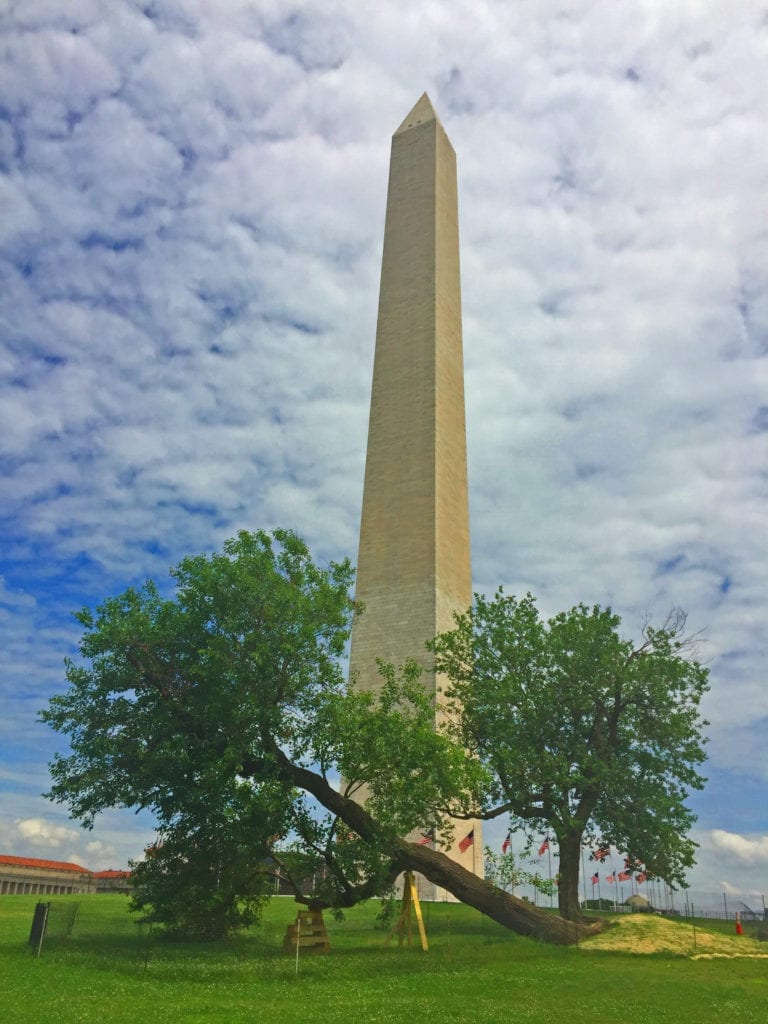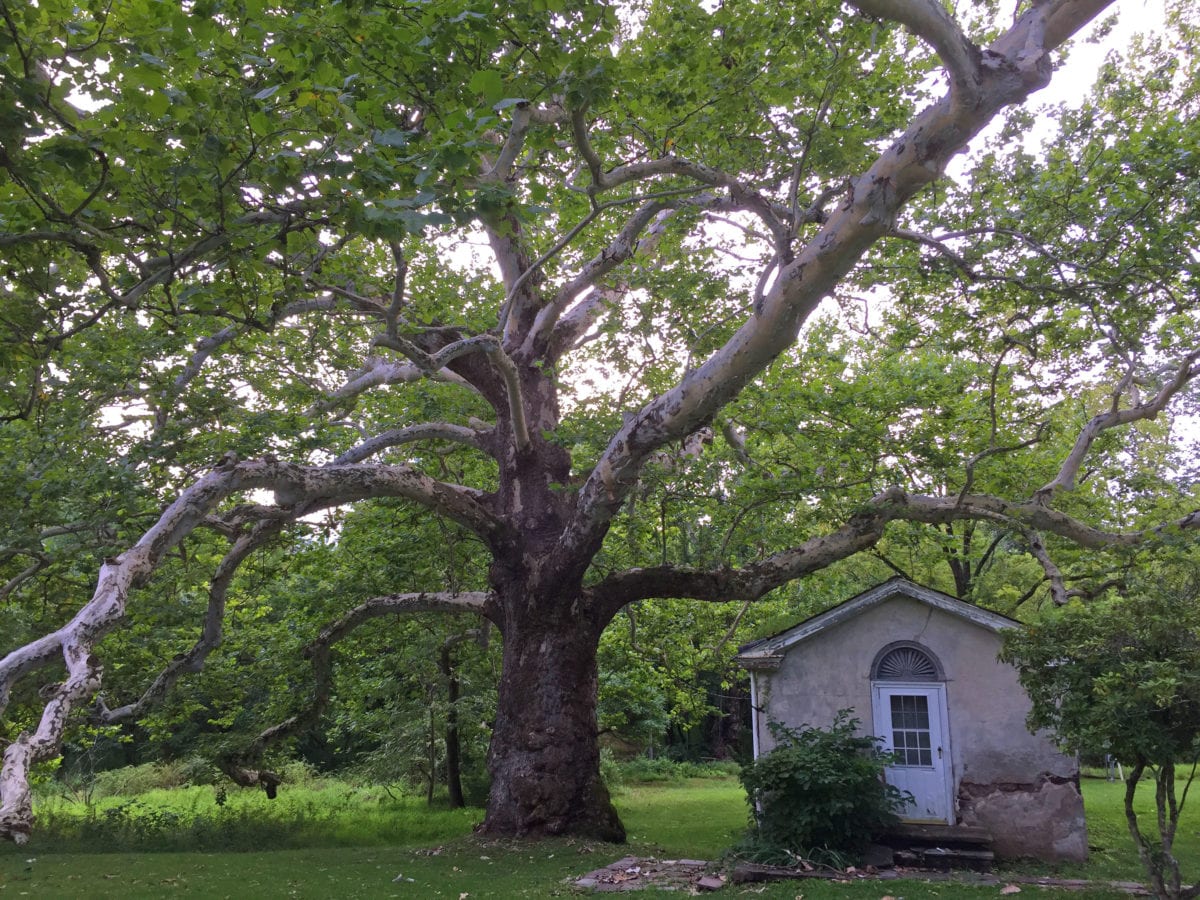
A damaged white mulberry “witness” tree by the Washington Monument on the National Mall in D.C: Glynn Wilson
WASHINGTON, D.C. – It was a cold day in the nation’s capital on February 21, 1885 when the Washington Monument was finally dedicated on the National Mall after decades of fits and starts and problems finding matching stones and money to build it, according to the National Park Service, and there was no mulberry tree in the official black and white photographs of the event. But about five years later, a white mulberry tree began to grow nearby and has stood tall in many pictures of the historic site since. That is until May, when wind and rain from a thunderstorm knocked the 55-foot tree down and set off a flurry of activity to save it.
Having stood so long in such an important place, the closest tree to the monument had earned its designation as a “witness tree” by the park service, and plant experts began working to see if they could keep it alive, even as it was denigrated as an “inanimate” or dead object by the local newspaper.
Should we forgive poor, local newspaper reporters for being so ignorant and anti-intellectual by letting them get away with such a slander?
According to Dale Broholm, a senior critic at the Rhode Island School of Design and a partner with the park service in the Witness Tree Project, an educational program that utilizes witness trees in the teaching of history, the incident could have been used as a “teachable moment” not only for students of design, but the general public at large.
“Witness trees have stood for a century or more, while around them battles have been waged, presidents have lived and died, and whole industries have peaked and declined,” says Daniel Cavicchi, an associate of Broholm’s who also works with the program. “Now each of these trees serves as an axis from which students can expand the scope of their thinking outward, from specific events to more complex questions about time and place, nature and culture.”
Since 2009, the NPS has teamed up with the Rhode Island School of Design to develop a collaborative model for teaching and learning centered on witness trees, long-standing trees that were present for key moments in American history.
In discussing this tree in a telephone interview with Broholm, we thought of many important historical events that took place in the vicinity of the tree, as well as important people who may have come in close contact with it.
Imagine President Theadore “Teddy” Roosevelt out for a ride on his horse “Little Texas” on his way to commune with nature on that little island in the Potomac River later to be named for him, Roosevelt Island. Imagine Roosevelt of “Rough Riders” fame stopping in the tree’s shade for a moment on a hot summer day while he occupied the White House from 1901 to 1909.
The tree was there when President Woodrow Wilson formed the National Park Service itself on August 25, 1916, by signing the National Park Service Organic Act.
The tree no doubt served as shade for some of the encamped “Bonus Army” in 1932, when 17,000 World War I vets joined a march of 43,000 people during the Great Depression to demand a cash-payment redemption of their service certificates from the war that were never honored by the federal government. Many had served as “Buffalo Soldiers” with “Black Jack” Pershing, who led African American troops during the Spanish-American War. He would later become commander of American forces during World War I.
But on July 28, 1932, U.S. Attorney General William D. Mitchell ordered the veterans removed from all government property. Washington police met with resistance, shots were fired, and two veterans were wounded and later died, according to historical accounts. President Herbert Hoover then ordered the U.S. Army to clear the marchers’ campsite. Army Chief of Staff General Douglas MacArthur commanded the infantry and cavalry and was supported by six tanks.
The Bonus Army marchers with their wives and children were driven out, and their shelters and belongings burned. So the dismal treatment of American veterans did not begin with Vietnam. It goes back a ways.
Of course it’s also easy to imagine and maybe even find pictures of hippies and Vietnam veterans camping out under the tree in the late 1960s and early 1970s, protesting that war.
Before that, on August 28, 1963, surely a number of people, including African Americans, probably rested under the tree before and after Dr. Martin Luther King Jr’s “I have a dream speech” from the steps of the Lincoln Memorial, just west over the Reflecting Pool. Perhaps Dr. King took a walk at some point and leaned on the tree himself, looking up at the Washington Monument.
Arborist and tree crew supervisor with the park service Jason Gillis provides an update on the plans to save the mulberry tree on the grounds of the Washington Monument.
Arborist and tree crew supervisor Jason Gillis provides an update on the plans to save the mulberry tree on the grounds of the Washington Monument. pic.twitter.com/2rb338B9Fq
— National Mall NPS (@NationalMallNPS) May 14, 2019
He said the tree is not only a witness tree, but also a “volunteer tree,” meaning it was not planted but grew on its own.
The tree appears in an aerial photograph from 1919, Gillis said, so he estimates it dates to about 1890. It was not there before 1887-88, when the final grading around the base of the Washington Monument was done, according to a Park Service study.
Because it’s the only big tree around the monument, he said, it has appeared in many photographs with the monument in the background.
“Our goal is to try to preserve it in the landscape without reducing it,” he told a reporter for The Washington Post. “It would stay in the same position. [We] basically just want to try to do a partial raise, give it artificial support with a custom prop, do a little bit of form pruning, then reestablish this root zone.”
The tree rested on wooden stands on its side on Wednesday when I was there, the roots covered in wet burlap to keep them from drying out in the sun. Beside it, as you can see in the photograph above, there is another smaller white mulberry tree, apparently part of the same root system and potentially at risk of dying too. Up until recently, there were up to four trees on the spot as shown in photographs dating to January 2016.
The mulberry tree will still be there, albeit lying down, on July 4, 2019, when another president speaks on the steps of the Lincoln Memorial to address the nation on Independence Day
Trump Officially Takes Over Independence Day Celebration in Washington for 2020 Reelection Campaign
—
Related
I also photographed another witness tree last year at Valley Forge.
Perhaps Can We Learn to Save Democracy from the Experience at Valley Forge














